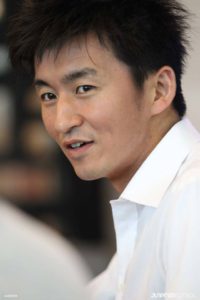- Column
2014/12/29 | Singapore
Football Media Talk – Singapore & Japan – 1st Half
Following the football match between the Japan and Brazil, in October 2014, a media talk was arranged between Japanese and Singaporean sports media persons by Institute for Future Asian Football.
The news reporters from many of the leading newspapers from both the countries gathered together to discuss the future of football in Asia, Japan and Singapore.
Japanese media, which seldom communicates with the media of the rest of the world, got an opportunity to speak to the Singapore media due to this media talk organised by the Asianfootball Institute (Institute for Future Asian Football). They exchanged information that led to a better understanding of the football in both the countries. They also discussed a planning process for the progress of football in Asia.
The media talk was mostly in English. Important parts of the discussion were translated into Japanese so as to increase the communication amongst all. Before the actual talk, a futsal game was organized which helped to break the language barrier.
<Agenda of the Media Talk >
・Current issues in Japanese football /Current issues in Singaporean football
・What Singapore wants to know about Japanese football
・What Japan wants to know about Singapore and Asian Football in general
<About the Facilitator of the Media Talk>
Kentaro Yomo(Institute for Future Asian Football / F.C. ASIA)
I think that J-League is the best among all the professional leagues in Asia. Having said that, there are many challenges ahead of J-League to perform better. One of the challenges is that there is a need to widen the market of football in Japan to South East Asia. In 2010, during the Football World Cup, when I had gone on a world tour to the football countries, I made many friends. The world tour was a very good experience and I wanted to make use the network and the knowledge that I gained during the word tour. Basically I want to explore ways and means as to how J-League and eventually Japanese football can collaborate with Asia and make progress. Japanese football community is indeed a very closed community and does not interact with local football communities in other countries. At such a time, I thought that Brazil – Japan game held in Singapore would be a great opportunity, as many Japanese football fans and people related to football would come to Singapore. Hence I planned the Sports Media Talk.
there are many challenges ahead of J-League to perform better. One of the challenges is that there is a need to widen the market of football in Japan to South East Asia. In 2010, during the Football World Cup, when I had gone on a world tour to the football countries, I made many friends. The world tour was a very good experience and I wanted to make use the network and the knowledge that I gained during the word tour. Basically I want to explore ways and means as to how J-League and eventually Japanese football can collaborate with Asia and make progress. Japanese football community is indeed a very closed community and does not interact with local football communities in other countries. At such a time, I thought that Brazil – Japan game held in Singapore would be a great opportunity, as many Japanese football fans and people related to football would come to Singapore. Hence I planned the Sports Media Talk.
Jun Tan(JUNPITER FUTBOL)
3 years ago, I created “JUNPITER FUTBOL” in order to circulate the information which  would be helpful to Singaporean football. The Singapore team is the defending champion of the Suzuki Cup and is one of the powerful teams amongst all the South East Asian teams. However, due to the budget constraints and problems in practice environment, S League has not made as much progress as expected. Since J-League is successful and leading the way, there are many things that S League can learn from them. Earlier I was a semi-professional football player, but now I have chosen a different profession as my career. Though I do not play football anymore, I have deep interest in Singaporean football. Hence I created JUNPITER FUTBOL. Many times I look for football related information from Japan as well.
would be helpful to Singaporean football. The Singapore team is the defending champion of the Suzuki Cup and is one of the powerful teams amongst all the South East Asian teams. However, due to the budget constraints and problems in practice environment, S League has not made as much progress as expected. Since J-League is successful and leading the way, there are many things that S League can learn from them. Earlier I was a semi-professional football player, but now I have chosen a different profession as my career. Though I do not play football anymore, I have deep interest in Singaporean football. Hence I created JUNPITER FUTBOL. Many times I look for football related information from Japan as well.
Saito Taiichiro (Global Football Academy / GFA Soria)
I visited Singapore in 1999 as a first professional Japanese Football Player. Since then, as a football player, I have had the opportunity to visit many countries like Ghana, Australia etc. In 2009, when I started Samurai Pte Ltd, a football business company along with my friends, my former experience was very useful. In 2012, I also started GFA Soriya, a football business company in Cambodia. I believe that football has unlimited potential. Football has the ability to connect people and spread positive energy all around. To spread this wonderful power that football has, I have been conducting football school, football events, sports marketing events and football events for social cause in various countries in South East Asia. I truly believe that football will make our lives more beautiful than ever.
football player, I have had the opportunity to visit many countries like Ghana, Australia etc. In 2009, when I started Samurai Pte Ltd, a football business company along with my friends, my former experience was very useful. In 2012, I also started GFA Soriya, a football business company in Cambodia. I believe that football has unlimited potential. Football has the ability to connect people and spread positive energy all around. To spread this wonderful power that football has, I have been conducting football school, football events, sports marketing events and football events for social cause in various countries in South East Asia. I truly believe that football will make our lives more beautiful than ever.
Part 1: Questions from Singapore Side
Q1 : What is the reason for the speedy progress of J.League in last 20 years?
– J.League was started in 1993, while S League was started after 3 years in 1996.
– The average number of spectators for S League games is 1000 while for J1 games it is 18000.
– Since the J.League licensing is very strict, it is mandatory that J1 games are played in stadiums with a minimum capacity of 15000 seats and for J2 games the capacity of the stadium should be minimum 10000 seats.
※Henceforth (J) Japanese Media (S) Singapore Media
(J) According to the sports point of view, we have a good training system in place. We also have proper licensing system for football coaches among other things. But from business point of view, it is very difficult to explain.
(J) I think that the timing also makes a difference. When J.League was formed, the bubble period was just over and the businesses were still doing well and there was still money to spend on sports. At the time when sports only meant professional baseball, a completely new and classy sport like football took roots in Japan and that was a great feeling. I think that if the J.League had formed 5 years earlier or later than 1993, then it would have been really difficult.
 (S) Was the formation of J-League intentionally at that timing?
(S) Was the formation of J-League intentionally at that timing?
(J) J-League was formed with the vision of 2002 World Cup in mind. The idea was to prepare a strong Japan team for the 2002 World Cup to be held 10 years later.
(J) Coincidentally J.League was formed in 1993 when the businesses were doing well. Nabisco cup was started in 1992. But by the beginning of 1994 the businesses were hit by recession. In 1995 or 1996, Professional Basket Ball was started but it had already been called off. Even today Japan does not have a professional basketball league.
(J) Another reason was that J.League had Mr. Kawabuchi who was a very strong leader. During that period, there were still many people in Japan who thought that it was a bit early to start a professional league in Japan. But he managed to convince more than half of them, which led to the formation of J.League.
(J) Good foreign players joined J.League as good salaries were offered to them. At that time, J.League was like Chinese club or Middle East Club where lot of Super Stars came and played. Due to the influence of the Star players and good training system in Japan (like rules to have a youth team, coaching licenses etc.) football in Japan made great progress.
(J) Singapore has a lot of money. But still the country does not invest in sports. Why?
(S) Well a business is a business. Definitely the companies in Singapore have a lot of money but most of them do not want to invest in football.
(S) Business culture in Singapore is very different from that in Japan. The companies will not invest unless you are able to show them the results. It is like the chicken and egg theory. Malaysia is different. There are various companies in Malaysia who have invested in sports. That has an effect on the players’ contracts. The players in Singapore generally have only yearly contracts.
(J) Singapore is a multicultural country. Singaporeans Chinese form more than 50% of the Singaporean population. Suppose if the football players from these Chinese players are brought into the team, will it not attract more investment in the football?
(S) According to my personal opinion, this topic is much deeper than that. I think football is more about passion and not about money. How much money can you earn by playing football? In Singapore the society gives greater importance to academics. Parents teach their children that studying hard is more important than playing football to get a good job to support the family. The Singaporean youngsters are being brought up in such an environment that values academics more than sports.
(J) In Japan, many companies sponsor sports. There is a consensus among businesses that companies in the places that have football clubs should support and sponsor the sport. E.g. Kyosera company has invested money in Kyoto Sanga, the local football club in Kyoto. This is also their way of returning their profit to the society by means of football. Singaporean government can also carry out such a campaign to educate the society that sports must be nurtured as a culture of the country.
 (S) Singapore is a very small country, only the size of Tokyo. Hence there are no regional specialities. There is nothing like, “I live in the east so I will support the team from the east”.
(S) Singapore is a very small country, only the size of Tokyo. Hence there are no regional specialities. There is nothing like, “I live in the east so I will support the team from the east”.
(S) One more thing, in the market, Singapore league is competing with the premier league and other foreign leagues. The Singaporean football fans are more interested in the premiere league players than the local players. So the fact is that Singaporean football has to compete with the popularity of the premier league and other foreign leagues more than the other local teams or the other professional local sports.
(J) What was said now, relates to the opinion about the timing of the formation of J.League. In 1993, the European marketing had still not reached Asia. If the same thing has to be done now, definitely it would be a competition with the premier league.
(S) Jokingly it can be said that, Singaporean football fans are Liverpool fans from before they are born. That is because their fathers are Liverpool fans and make them watch the matches with them.
Q2 : Presently what is the biggest challenge for the J.League?
(J) Many famous players that have played for the Japan team have moved to foreign leagues leaving a void in the Japanese league.
(J) If the numbers of national star players like Honda and Kagawa, players that can draw the crowd is getting lesser in the domestic games, then such games are not broadcast on the TV and also do not get any sponsors. As a result of this the J.League is not reaching the right audience.
and also do not get any sponsors. As a result of this the J.League is not reaching the right audience.
(J) I think J.League has still not come out of the scope of being a corporate sport. In these 20 years it looks like it has made a huge progress due to a strong local patronage but the league teams are still heavily dependent on the sponsor companies and in that sense there is still a long way to go to be pro league. If a club faces loss then without the support of the parent sponsor company it is next to impossible to recover from the losses. This year Diego Forlan could join Cerezo Osaka only due to the money from Yanmar, Sky Perfect etc.
(S) How is the situation regarding merchandise and television broadcasting rights?
(J) In J.League the income from merchandise and television broadcasts is 50 %. Of course this may slightly vary depending on the different teams.
(S) S league does not have much merchandise.
(S) If the J.League players join foreign clubs, is it not a good thing? The value of shares of J.League will increase and the prestige of the league will also rise.
(J) It is good the players as individuals. They get very high payments. But it is not good for the promotion of J.League.
Eventually the players that have joined foreign clubs will definitely come back after gaining a good experience. But whether such players can be taken back depends on the suitability. For that, the J.League need to have a big budget to pay the players that have come back from the big European clubs.
(J) Nakamura Shunsuke playing in Yokohama F. Marinos Club can be seen as the success model.
(J) Basically is a star player the key element for the business of the team? If we consider the promotion policies of Albirex Niigata team, then we can see that though they do have any star players, still they are doing quite well.
(J) If the theme is to just have a football club in town, then it is fine to run a club with 1 billion yen. But you want to form a club of the scale of 10 billion yen, which J.League does not have now, and then it is difficult to point out just a single method that will work.
(J) Now is the 34th round of this season of J.League. From the surveys that were done in the stadium during the year, it was seen that a large number people had come to watch the matches more than 15 times. This means that people have watched almost all the home games and that these people are hard core fans. Such hard core fans also have paid sky perfect channels to watch football. The football marketing is presently only limited to these hard core fans. But the general public other than the hard core fans do not even know about J.League matches if they do not subscribe to paid football channels. If star players and players from Japanese national team do not play more for the J.League the general public will not develop interest in J.League.
Summary of the first Half of the Media Talk
Since the J.League was started before the propagation of European football in Asia, J.League was able to develop the domestic market for football and with steady improvement in competitiveness has accomplished great progress. But still there is a long way to go. In order to achieve a breakthrough to match the mega clubs in the premiere league, it is important to devise attractive content of the matches using various different ways and means.
(Second half of the Media Talk …to be continued/ will be uploaded soon)
(Institute for Future Asian Football – Hasegawa/Yomo)
- Hot News
- Hot Column
 2014 Witnesses a Dramatic Change in the Rising Cambodian Football League with a Speedy Improvement in the Relationship with Japan
2014 Witnesses a Dramatic Change in the Rising Cambodian Football League with a Speedy Improvement in the Relationship with Japan  J.League To Win Over Southeast Asian Fans
J.League To Win Over Southeast Asian Fans  Japan’s opponent: The best amateur football club in the world
Japan’s opponent: The best amateur football club in the world  Football Media Talk – Singapore and Japan – 2nd Half
Football Media Talk – Singapore and Japan – 2nd Half  Future of the S.League?
Future of the S.League?







